Analyzing Talent Management Strategies: A Sainsbury Case Study
VerifiedAdded on 2022/12/27
|22
|5307
|75
Report
AI Summary
This report examines the impact of talent management strategies on organizational success, using Sainsbury as a case study. It begins with an introduction to talent management, emphasizing its importance in attracting, retaining, and motivating employees. The report outlines research objectives, questions, and a literature review covering talent management concepts and challenges faced by Sainsbury, such as employee retention and diversity management. The methodology section details the research philosophy, approach, strategy, and ethical considerations. The report analyzes the impact of talent management strategies on the success of Sainsbury, offering a detailed overview of the research process, findings, and insights, and concludes with recommendations and reflection on the topic. The research utilizes both primary and secondary data sources to provide a comprehensive analysis of talent management practices.

Unit 11: Research Project
Paraphrase This Document
Need a fresh take? Get an instant paraphrase of this document with our AI Paraphraser
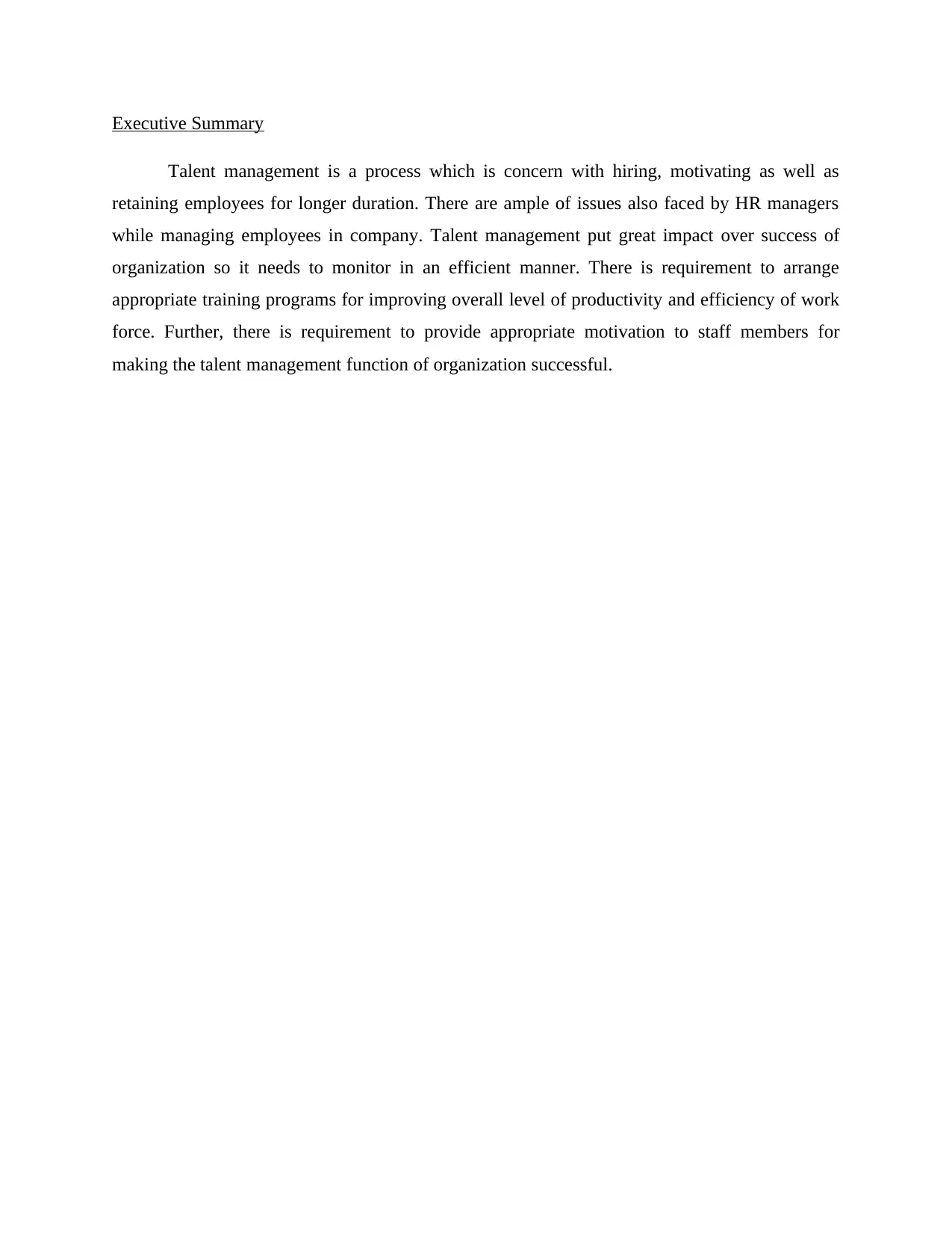
Executive Summary
Talent management is a process which is concern with hiring, motivating as well as
retaining employees for longer duration. There are ample of issues also faced by HR managers
while managing employees in company. Talent management put great impact over success of
organization so it needs to monitor in an efficient manner. There is requirement to arrange
appropriate training programs for improving overall level of productivity and efficiency of work
force. Further, there is requirement to provide appropriate motivation to staff members for
making the talent management function of organization successful.
Talent management is a process which is concern with hiring, motivating as well as
retaining employees for longer duration. There are ample of issues also faced by HR managers
while managing employees in company. Talent management put great impact over success of
organization so it needs to monitor in an efficient manner. There is requirement to arrange
appropriate training programs for improving overall level of productivity and efficiency of work
force. Further, there is requirement to provide appropriate motivation to staff members for
making the talent management function of organization successful.
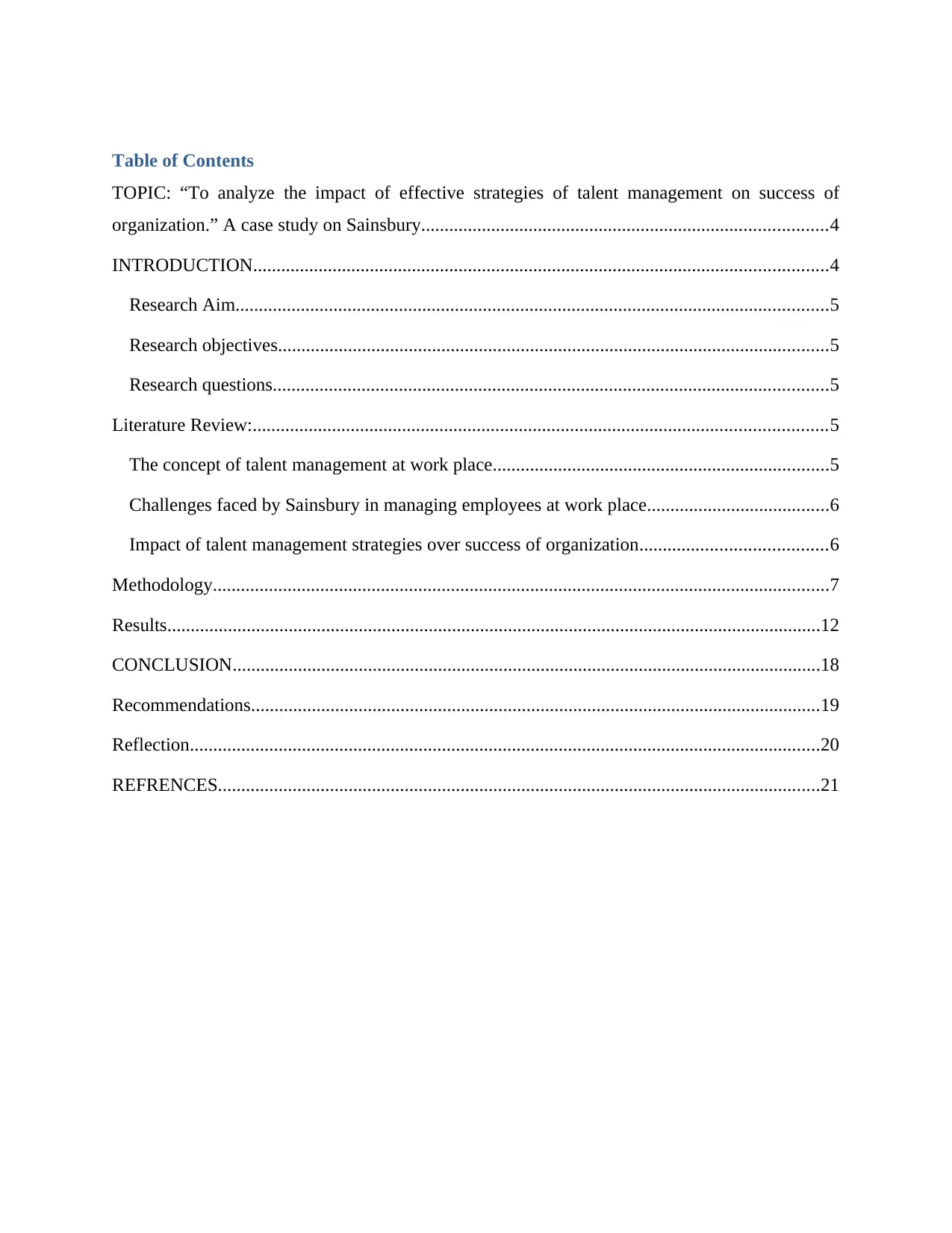
Table of Contents
TOPIC: “To analyze the impact of effective strategies of talent management on success of
organization.” A case study on Sainsbury.......................................................................................4
INTRODUCTION...........................................................................................................................4
Research Aim...............................................................................................................................5
Research objectives......................................................................................................................5
Research questions.......................................................................................................................5
Literature Review:...........................................................................................................................5
The concept of talent management at work place........................................................................5
Challenges faced by Sainsbury in managing employees at work place.......................................6
Impact of talent management strategies over success of organization........................................6
Methodology....................................................................................................................................7
Results............................................................................................................................................12
CONCLUSION..............................................................................................................................18
Recommendations..........................................................................................................................19
Reflection.......................................................................................................................................20
REFRENCES.................................................................................................................................21
TOPIC: “To analyze the impact of effective strategies of talent management on success of
organization.” A case study on Sainsbury.......................................................................................4
INTRODUCTION...........................................................................................................................4
Research Aim...............................................................................................................................5
Research objectives......................................................................................................................5
Research questions.......................................................................................................................5
Literature Review:...........................................................................................................................5
The concept of talent management at work place........................................................................5
Challenges faced by Sainsbury in managing employees at work place.......................................6
Impact of talent management strategies over success of organization........................................6
Methodology....................................................................................................................................7
Results............................................................................................................................................12
CONCLUSION..............................................................................................................................18
Recommendations..........................................................................................................................19
Reflection.......................................................................................................................................20
REFRENCES.................................................................................................................................21
⊘ This is a preview!⊘
Do you want full access?
Subscribe today to unlock all pages.

Trusted by 1+ million students worldwide
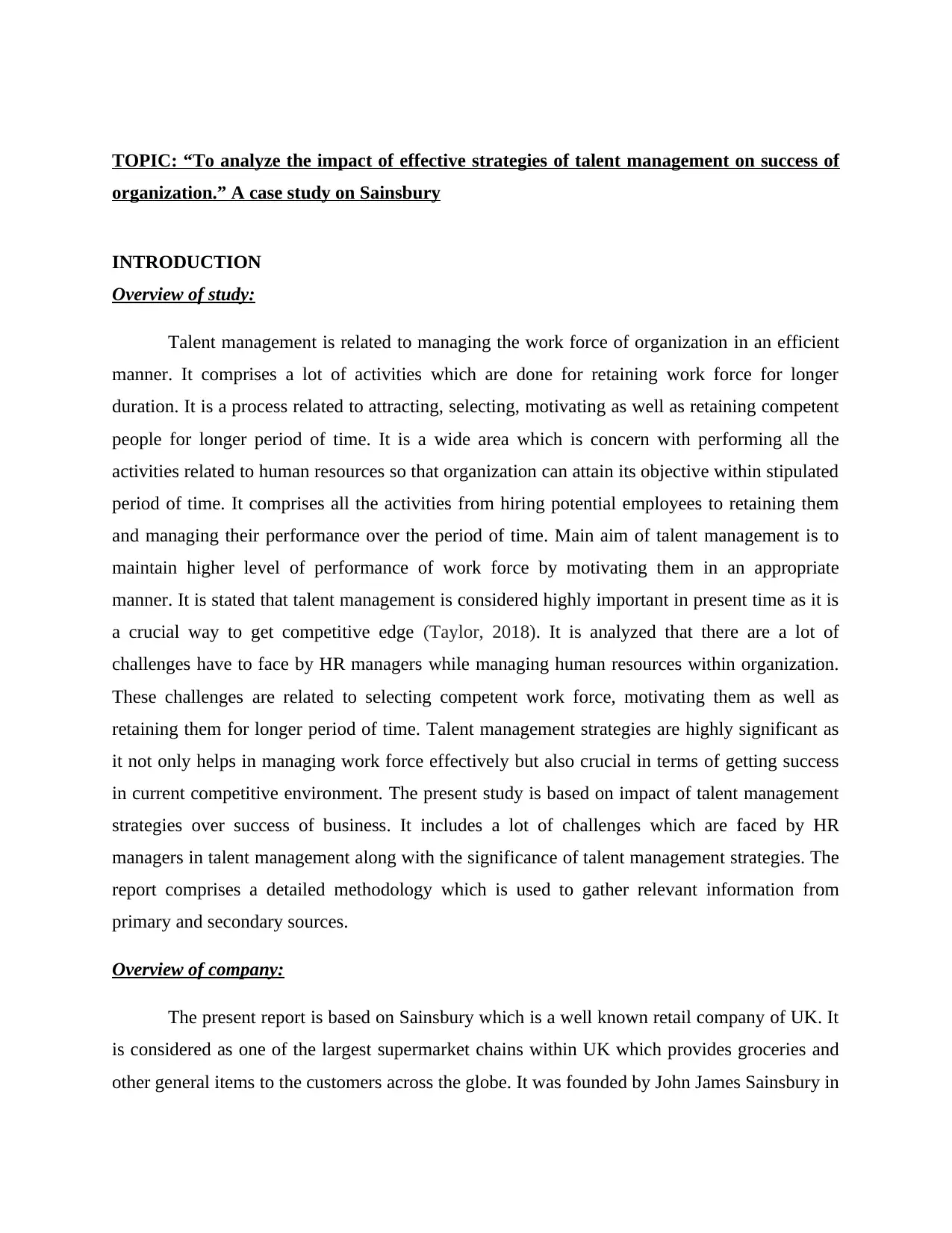
TOPIC: “To analyze the impact of effective strategies of talent management on success of
organization.” A case study on Sainsbury
INTRODUCTION
Overview of study:
Talent management is related to managing the work force of organization in an efficient
manner. It comprises a lot of activities which are done for retaining work force for longer
duration. It is a process related to attracting, selecting, motivating as well as retaining competent
people for longer period of time. It is a wide area which is concern with performing all the
activities related to human resources so that organization can attain its objective within stipulated
period of time. It comprises all the activities from hiring potential employees to retaining them
and managing their performance over the period of time. Main aim of talent management is to
maintain higher level of performance of work force by motivating them in an appropriate
manner. It is stated that talent management is considered highly important in present time as it is
a crucial way to get competitive edge (Taylor, 2018). It is analyzed that there are a lot of
challenges have to face by HR managers while managing human resources within organization.
These challenges are related to selecting competent work force, motivating them as well as
retaining them for longer period of time. Talent management strategies are highly significant as
it not only helps in managing work force effectively but also crucial in terms of getting success
in current competitive environment. The present study is based on impact of talent management
strategies over success of business. It includes a lot of challenges which are faced by HR
managers in talent management along with the significance of talent management strategies. The
report comprises a detailed methodology which is used to gather relevant information from
primary and secondary sources.
Overview of company:
The present report is based on Sainsbury which is a well known retail company of UK. It
is considered as one of the largest supermarket chains within UK which provides groceries and
other general items to the customers across the globe. It was founded by John James Sainsbury in
organization.” A case study on Sainsbury
INTRODUCTION
Overview of study:
Talent management is related to managing the work force of organization in an efficient
manner. It comprises a lot of activities which are done for retaining work force for longer
duration. It is a process related to attracting, selecting, motivating as well as retaining competent
people for longer period of time. It is a wide area which is concern with performing all the
activities related to human resources so that organization can attain its objective within stipulated
period of time. It comprises all the activities from hiring potential employees to retaining them
and managing their performance over the period of time. Main aim of talent management is to
maintain higher level of performance of work force by motivating them in an appropriate
manner. It is stated that talent management is considered highly important in present time as it is
a crucial way to get competitive edge (Taylor, 2018). It is analyzed that there are a lot of
challenges have to face by HR managers while managing human resources within organization.
These challenges are related to selecting competent work force, motivating them as well as
retaining them for longer period of time. Talent management strategies are highly significant as
it not only helps in managing work force effectively but also crucial in terms of getting success
in current competitive environment. The present study is based on impact of talent management
strategies over success of business. It includes a lot of challenges which are faced by HR
managers in talent management along with the significance of talent management strategies. The
report comprises a detailed methodology which is used to gather relevant information from
primary and secondary sources.
Overview of company:
The present report is based on Sainsbury which is a well known retail company of UK. It
is considered as one of the largest supermarket chains within UK which provides groceries and
other general items to the customers across the globe. It was founded by John James Sainsbury in
Paraphrase This Document
Need a fresh take? Get an instant paraphrase of this document with our AI Paraphraser
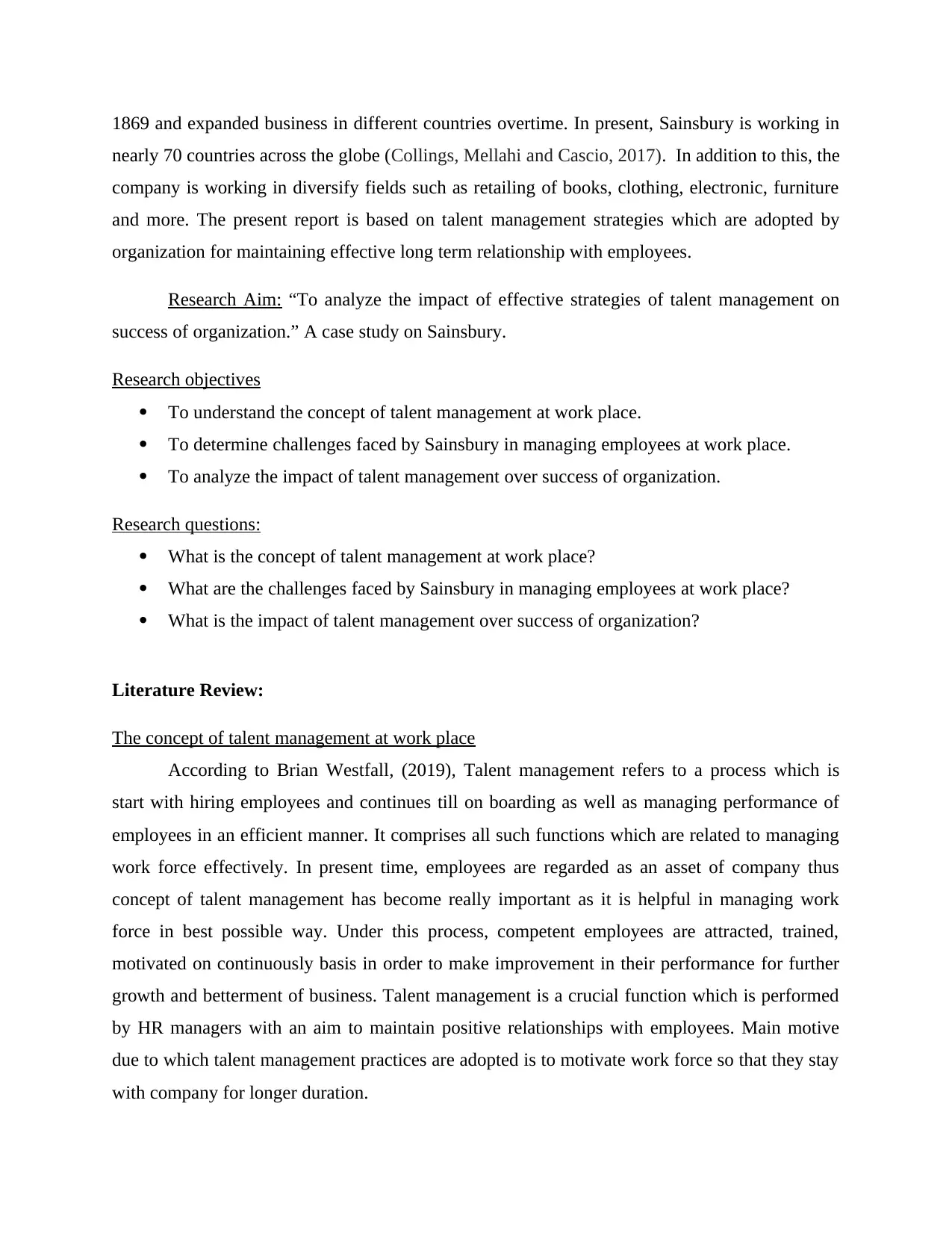
1869 and expanded business in different countries overtime. In present, Sainsbury is working in
nearly 70 countries across the globe (Collings, Mellahi and Cascio, 2017). In addition to this, the
company is working in diversify fields such as retailing of books, clothing, electronic, furniture
and more. The present report is based on talent management strategies which are adopted by
organization for maintaining effective long term relationship with employees.
Research Aim: “To analyze the impact of effective strategies of talent management on
success of organization.” A case study on Sainsbury.
Research objectives
To understand the concept of talent management at work place.
To determine challenges faced by Sainsbury in managing employees at work place.
To analyze the impact of talent management over success of organization.
Research questions:
What is the concept of talent management at work place?
What are the challenges faced by Sainsbury in managing employees at work place?
What is the impact of talent management over success of organization?
Literature Review:
The concept of talent management at work place
According to Brian Westfall, (2019), Talent management refers to a process which is
start with hiring employees and continues till on boarding as well as managing performance of
employees in an efficient manner. It comprises all such functions which are related to managing
work force effectively. In present time, employees are regarded as an asset of company thus
concept of talent management has become really important as it is helpful in managing work
force in best possible way. Under this process, competent employees are attracted, trained,
motivated on continuously basis in order to make improvement in their performance for further
growth and betterment of business. Talent management is a crucial function which is performed
by HR managers with an aim to maintain positive relationships with employees. Main motive
due to which talent management practices are adopted is to motivate work force so that they stay
with company for longer duration.
nearly 70 countries across the globe (Collings, Mellahi and Cascio, 2017). In addition to this, the
company is working in diversify fields such as retailing of books, clothing, electronic, furniture
and more. The present report is based on talent management strategies which are adopted by
organization for maintaining effective long term relationship with employees.
Research Aim: “To analyze the impact of effective strategies of talent management on
success of organization.” A case study on Sainsbury.
Research objectives
To understand the concept of talent management at work place.
To determine challenges faced by Sainsbury in managing employees at work place.
To analyze the impact of talent management over success of organization.
Research questions:
What is the concept of talent management at work place?
What are the challenges faced by Sainsbury in managing employees at work place?
What is the impact of talent management over success of organization?
Literature Review:
The concept of talent management at work place
According to Brian Westfall, (2019), Talent management refers to a process which is
start with hiring employees and continues till on boarding as well as managing performance of
employees in an efficient manner. It comprises all such functions which are related to managing
work force effectively. In present time, employees are regarded as an asset of company thus
concept of talent management has become really important as it is helpful in managing work
force in best possible way. Under this process, competent employees are attracted, trained,
motivated on continuously basis in order to make improvement in their performance for further
growth and betterment of business. Talent management is a crucial function which is performed
by HR managers with an aim to maintain positive relationships with employees. Main motive
due to which talent management practices are adopted is to motivate work force so that they stay
with company for longer duration.
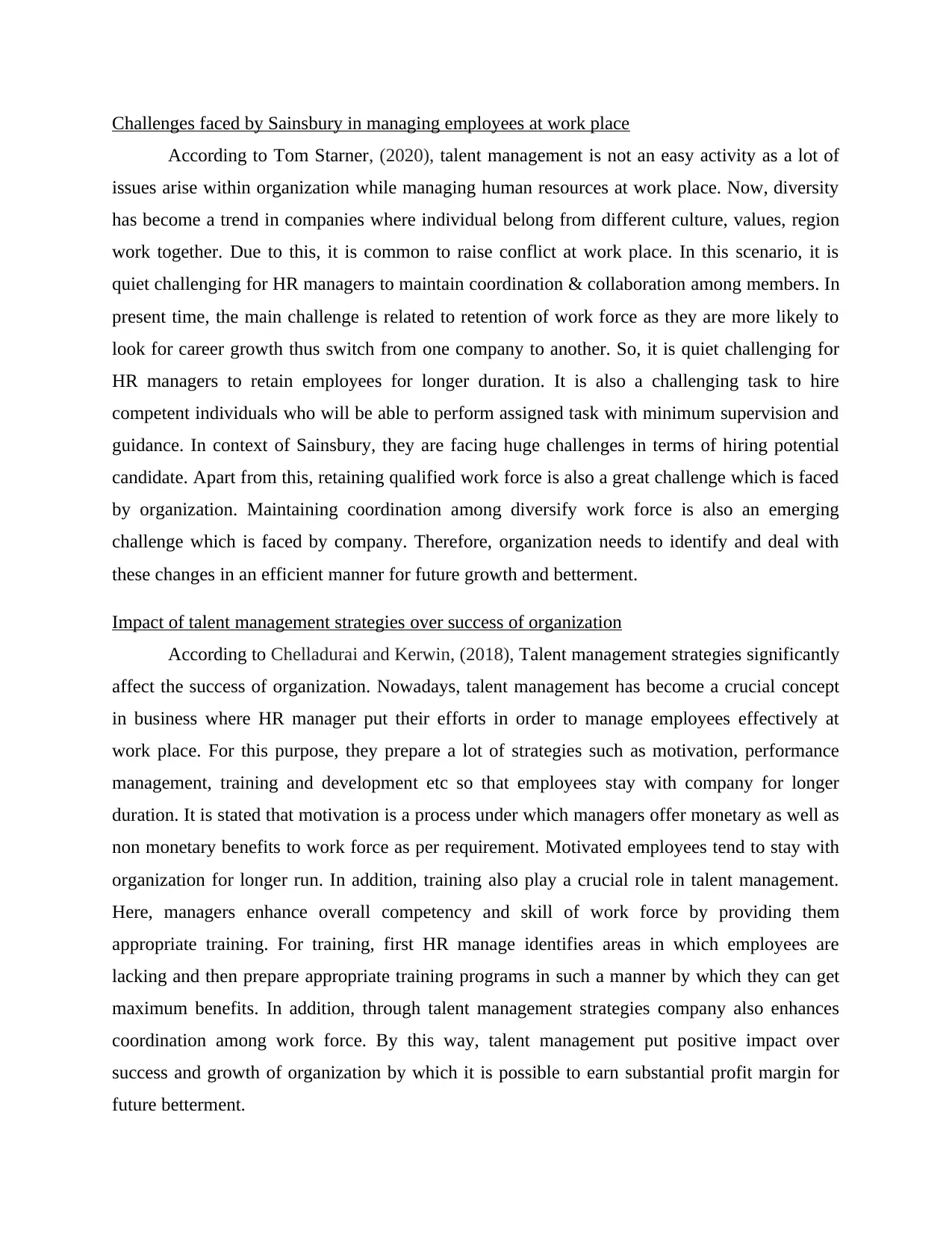
Challenges faced by Sainsbury in managing employees at work place
According to Tom Starner, (2020), talent management is not an easy activity as a lot of
issues arise within organization while managing human resources at work place. Now, diversity
has become a trend in companies where individual belong from different culture, values, region
work together. Due to this, it is common to raise conflict at work place. In this scenario, it is
quiet challenging for HR managers to maintain coordination & collaboration among members. In
present time, the main challenge is related to retention of work force as they are more likely to
look for career growth thus switch from one company to another. So, it is quiet challenging for
HR managers to retain employees for longer duration. It is also a challenging task to hire
competent individuals who will be able to perform assigned task with minimum supervision and
guidance. In context of Sainsbury, they are facing huge challenges in terms of hiring potential
candidate. Apart from this, retaining qualified work force is also a great challenge which is faced
by organization. Maintaining coordination among diversify work force is also an emerging
challenge which is faced by company. Therefore, organization needs to identify and deal with
these changes in an efficient manner for future growth and betterment.
Impact of talent management strategies over success of organization
According to Chelladurai and Kerwin, (2018), Talent management strategies significantly
affect the success of organization. Nowadays, talent management has become a crucial concept
in business where HR manager put their efforts in order to manage employees effectively at
work place. For this purpose, they prepare a lot of strategies such as motivation, performance
management, training and development etc so that employees stay with company for longer
duration. It is stated that motivation is a process under which managers offer monetary as well as
non monetary benefits to work force as per requirement. Motivated employees tend to stay with
organization for longer run. In addition, training also play a crucial role in talent management.
Here, managers enhance overall competency and skill of work force by providing them
appropriate training. For training, first HR manage identifies areas in which employees are
lacking and then prepare appropriate training programs in such a manner by which they can get
maximum benefits. In addition, through talent management strategies company also enhances
coordination among work force. By this way, talent management put positive impact over
success and growth of organization by which it is possible to earn substantial profit margin for
future betterment.
According to Tom Starner, (2020), talent management is not an easy activity as a lot of
issues arise within organization while managing human resources at work place. Now, diversity
has become a trend in companies where individual belong from different culture, values, region
work together. Due to this, it is common to raise conflict at work place. In this scenario, it is
quiet challenging for HR managers to maintain coordination & collaboration among members. In
present time, the main challenge is related to retention of work force as they are more likely to
look for career growth thus switch from one company to another. So, it is quiet challenging for
HR managers to retain employees for longer duration. It is also a challenging task to hire
competent individuals who will be able to perform assigned task with minimum supervision and
guidance. In context of Sainsbury, they are facing huge challenges in terms of hiring potential
candidate. Apart from this, retaining qualified work force is also a great challenge which is faced
by organization. Maintaining coordination among diversify work force is also an emerging
challenge which is faced by company. Therefore, organization needs to identify and deal with
these changes in an efficient manner for future growth and betterment.
Impact of talent management strategies over success of organization
According to Chelladurai and Kerwin, (2018), Talent management strategies significantly
affect the success of organization. Nowadays, talent management has become a crucial concept
in business where HR manager put their efforts in order to manage employees effectively at
work place. For this purpose, they prepare a lot of strategies such as motivation, performance
management, training and development etc so that employees stay with company for longer
duration. It is stated that motivation is a process under which managers offer monetary as well as
non monetary benefits to work force as per requirement. Motivated employees tend to stay with
organization for longer run. In addition, training also play a crucial role in talent management.
Here, managers enhance overall competency and skill of work force by providing them
appropriate training. For training, first HR manage identifies areas in which employees are
lacking and then prepare appropriate training programs in such a manner by which they can get
maximum benefits. In addition, through talent management strategies company also enhances
coordination among work force. By this way, talent management put positive impact over
success and growth of organization by which it is possible to earn substantial profit margin for
future betterment.
⊘ This is a preview!⊘
Do you want full access?
Subscribe today to unlock all pages.

Trusted by 1+ million students worldwide
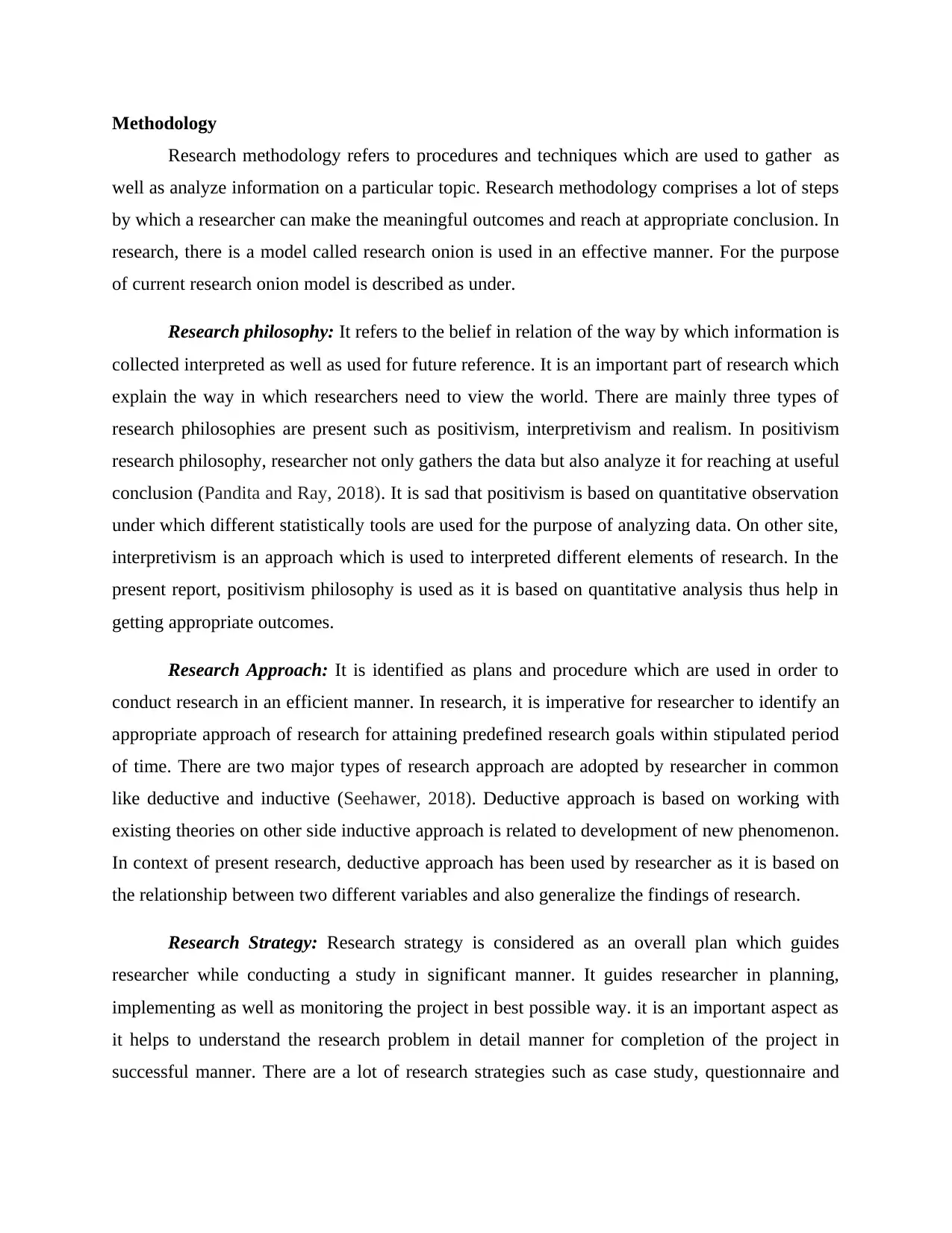
Methodology
Research methodology refers to procedures and techniques which are used to gather as
well as analyze information on a particular topic. Research methodology comprises a lot of steps
by which a researcher can make the meaningful outcomes and reach at appropriate conclusion. In
research, there is a model called research onion is used in an effective manner. For the purpose
of current research onion model is described as under.
Research philosophy: It refers to the belief in relation of the way by which information is
collected interpreted as well as used for future reference. It is an important part of research which
explain the way in which researchers need to view the world. There are mainly three types of
research philosophies are present such as positivism, interpretivism and realism. In positivism
research philosophy, researcher not only gathers the data but also analyze it for reaching at useful
conclusion (Pandita and Ray, 2018). It is sad that positivism is based on quantitative observation
under which different statistically tools are used for the purpose of analyzing data. On other site,
interpretivism is an approach which is used to interpreted different elements of research. In the
present report, positivism philosophy is used as it is based on quantitative analysis thus help in
getting appropriate outcomes.
Research Approach: It is identified as plans and procedure which are used in order to
conduct research in an efficient manner. In research, it is imperative for researcher to identify an
appropriate approach of research for attaining predefined research goals within stipulated period
of time. There are two major types of research approach are adopted by researcher in common
like deductive and inductive (Seehawer, 2018). Deductive approach is based on working with
existing theories on other side inductive approach is related to development of new phenomenon.
In context of present research, deductive approach has been used by researcher as it is based on
the relationship between two different variables and also generalize the findings of research.
Research Strategy: Research strategy is considered as an overall plan which guides
researcher while conducting a study in significant manner. It guides researcher in planning,
implementing as well as monitoring the project in best possible way. it is an important aspect as
it helps to understand the research problem in detail manner for completion of the project in
successful manner. There are a lot of research strategies such as case study, questionnaire and
Research methodology refers to procedures and techniques which are used to gather as
well as analyze information on a particular topic. Research methodology comprises a lot of steps
by which a researcher can make the meaningful outcomes and reach at appropriate conclusion. In
research, there is a model called research onion is used in an effective manner. For the purpose
of current research onion model is described as under.
Research philosophy: It refers to the belief in relation of the way by which information is
collected interpreted as well as used for future reference. It is an important part of research which
explain the way in which researchers need to view the world. There are mainly three types of
research philosophies are present such as positivism, interpretivism and realism. In positivism
research philosophy, researcher not only gathers the data but also analyze it for reaching at useful
conclusion (Pandita and Ray, 2018). It is sad that positivism is based on quantitative observation
under which different statistically tools are used for the purpose of analyzing data. On other site,
interpretivism is an approach which is used to interpreted different elements of research. In the
present report, positivism philosophy is used as it is based on quantitative analysis thus help in
getting appropriate outcomes.
Research Approach: It is identified as plans and procedure which are used in order to
conduct research in an efficient manner. In research, it is imperative for researcher to identify an
appropriate approach of research for attaining predefined research goals within stipulated period
of time. There are two major types of research approach are adopted by researcher in common
like deductive and inductive (Seehawer, 2018). Deductive approach is based on working with
existing theories on other side inductive approach is related to development of new phenomenon.
In context of present research, deductive approach has been used by researcher as it is based on
the relationship between two different variables and also generalize the findings of research.
Research Strategy: Research strategy is considered as an overall plan which guides
researcher while conducting a study in significant manner. It guides researcher in planning,
implementing as well as monitoring the project in best possible way. it is an important aspect as
it helps to understand the research problem in detail manner for completion of the project in
successful manner. There are a lot of research strategies such as case study, questionnaire and
Paraphrase This Document
Need a fresh take? Get an instant paraphrase of this document with our AI Paraphraser
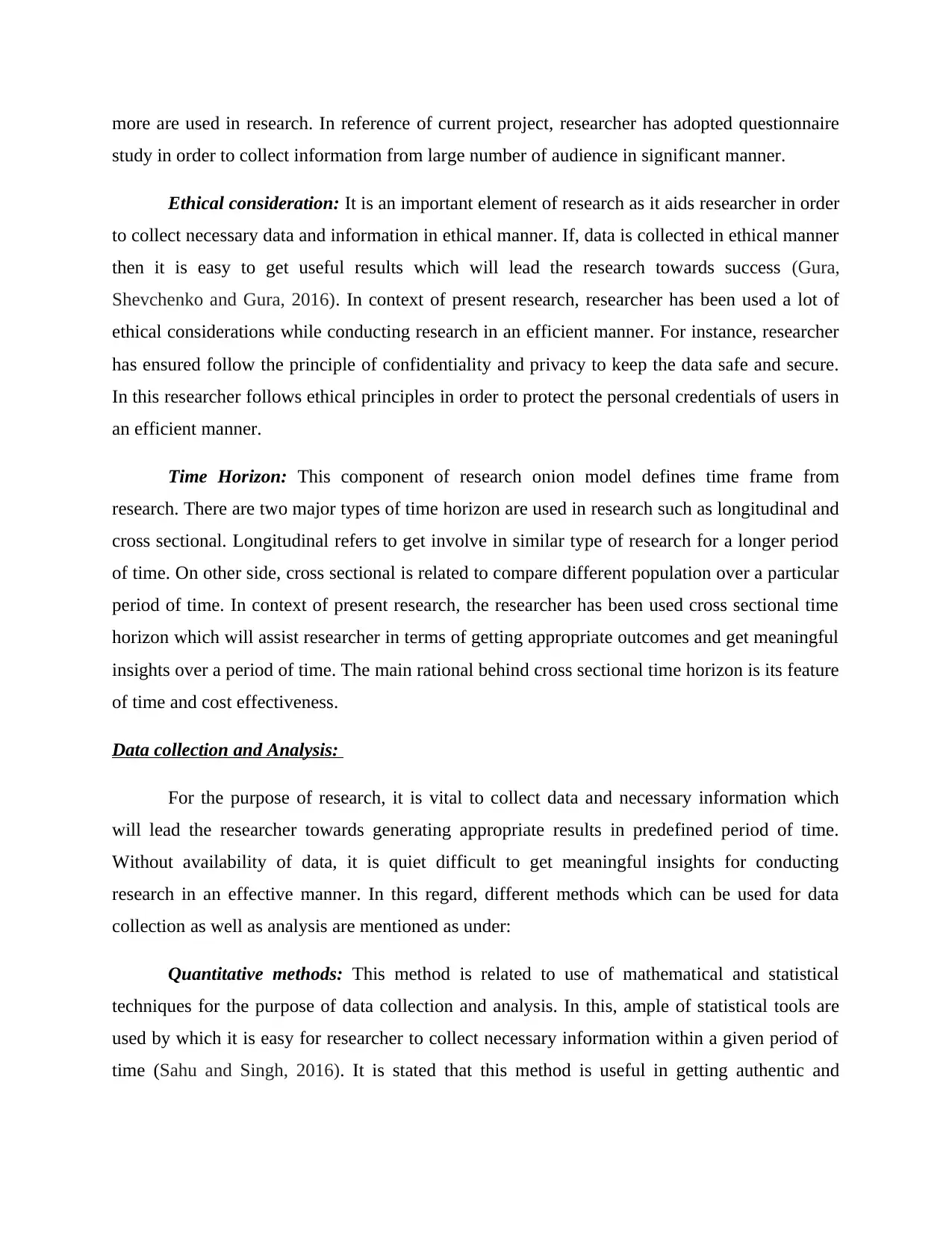
more are used in research. In reference of current project, researcher has adopted questionnaire
study in order to collect information from large number of audience in significant manner.
Ethical consideration: It is an important element of research as it aids researcher in order
to collect necessary data and information in ethical manner. If, data is collected in ethical manner
then it is easy to get useful results which will lead the research towards success (Gura,
Shevchenko and Gura, 2016). In context of present research, researcher has been used a lot of
ethical considerations while conducting research in an efficient manner. For instance, researcher
has ensured follow the principle of confidentiality and privacy to keep the data safe and secure.
In this researcher follows ethical principles in order to protect the personal credentials of users in
an efficient manner.
Time Horizon: This component of research onion model defines time frame from
research. There are two major types of time horizon are used in research such as longitudinal and
cross sectional. Longitudinal refers to get involve in similar type of research for a longer period
of time. On other side, cross sectional is related to compare different population over a particular
period of time. In context of present research, the researcher has been used cross sectional time
horizon which will assist researcher in terms of getting appropriate outcomes and get meaningful
insights over a period of time. The main rational behind cross sectional time horizon is its feature
of time and cost effectiveness.
Data collection and Analysis:
For the purpose of research, it is vital to collect data and necessary information which
will lead the researcher towards generating appropriate results in predefined period of time.
Without availability of data, it is quiet difficult to get meaningful insights for conducting
research in an effective manner. In this regard, different methods which can be used for data
collection as well as analysis are mentioned as under:
Quantitative methods: This method is related to use of mathematical and statistical
techniques for the purpose of data collection and analysis. In this, ample of statistical tools are
used by which it is easy for researcher to collect necessary information within a given period of
time (Sahu and Singh, 2016). It is stated that this method is useful in getting authentic and
study in order to collect information from large number of audience in significant manner.
Ethical consideration: It is an important element of research as it aids researcher in order
to collect necessary data and information in ethical manner. If, data is collected in ethical manner
then it is easy to get useful results which will lead the research towards success (Gura,
Shevchenko and Gura, 2016). In context of present research, researcher has been used a lot of
ethical considerations while conducting research in an efficient manner. For instance, researcher
has ensured follow the principle of confidentiality and privacy to keep the data safe and secure.
In this researcher follows ethical principles in order to protect the personal credentials of users in
an efficient manner.
Time Horizon: This component of research onion model defines time frame from
research. There are two major types of time horizon are used in research such as longitudinal and
cross sectional. Longitudinal refers to get involve in similar type of research for a longer period
of time. On other side, cross sectional is related to compare different population over a particular
period of time. In context of present research, the researcher has been used cross sectional time
horizon which will assist researcher in terms of getting appropriate outcomes and get meaningful
insights over a period of time. The main rational behind cross sectional time horizon is its feature
of time and cost effectiveness.
Data collection and Analysis:
For the purpose of research, it is vital to collect data and necessary information which
will lead the researcher towards generating appropriate results in predefined period of time.
Without availability of data, it is quiet difficult to get meaningful insights for conducting
research in an effective manner. In this regard, different methods which can be used for data
collection as well as analysis are mentioned as under:
Quantitative methods: This method is related to use of mathematical and statistical
techniques for the purpose of data collection and analysis. In this, ample of statistical tools are
used by which it is easy for researcher to collect necessary information within a given period of
time (Sahu and Singh, 2016). It is stated that this method is useful in getting authentic and
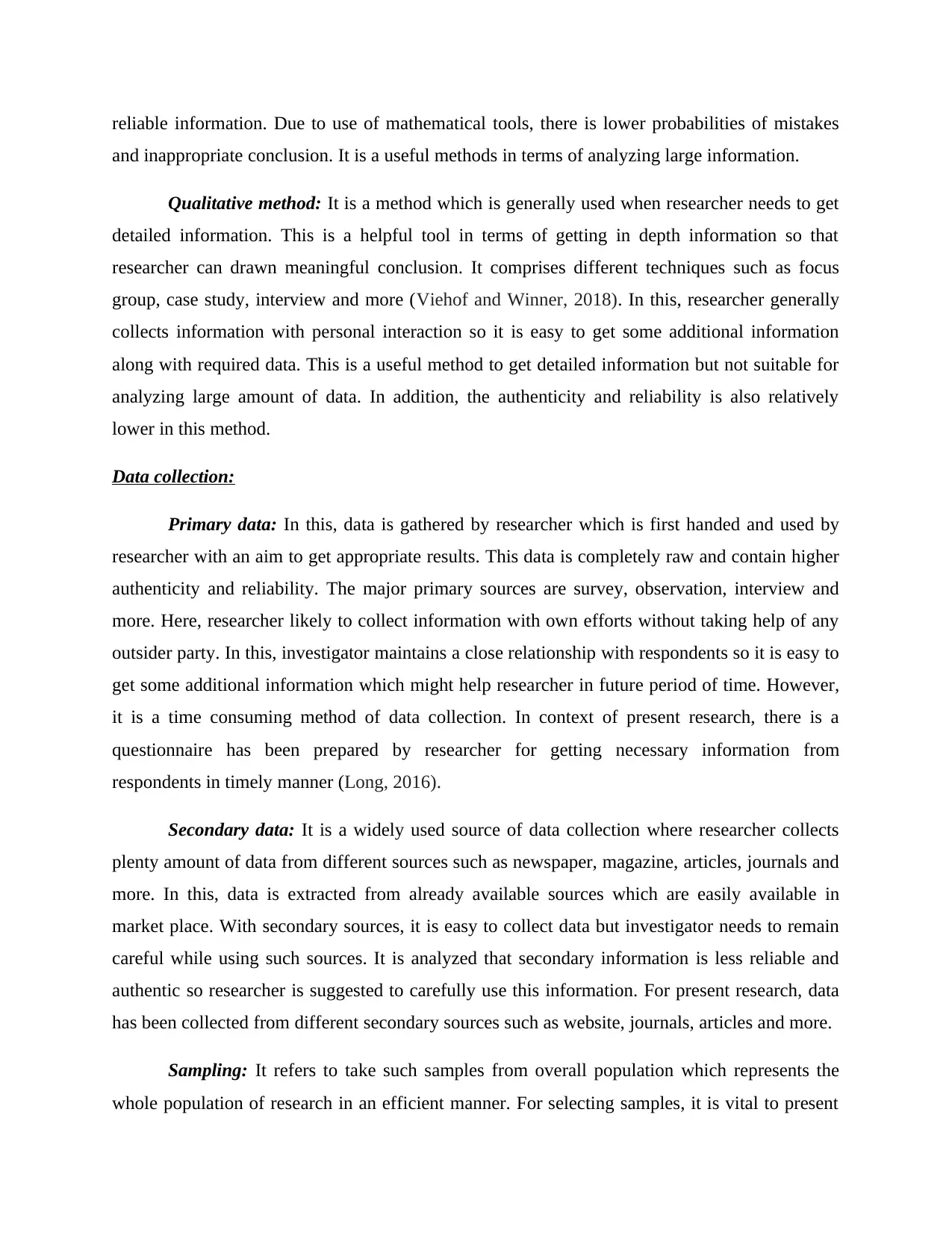
reliable information. Due to use of mathematical tools, there is lower probabilities of mistakes
and inappropriate conclusion. It is a useful methods in terms of analyzing large information.
Qualitative method: It is a method which is generally used when researcher needs to get
detailed information. This is a helpful tool in terms of getting in depth information so that
researcher can drawn meaningful conclusion. It comprises different techniques such as focus
group, case study, interview and more (Viehof and Winner, 2018). In this, researcher generally
collects information with personal interaction so it is easy to get some additional information
along with required data. This is a useful method to get detailed information but not suitable for
analyzing large amount of data. In addition, the authenticity and reliability is also relatively
lower in this method.
Data collection:
Primary data: In this, data is gathered by researcher which is first handed and used by
researcher with an aim to get appropriate results. This data is completely raw and contain higher
authenticity and reliability. The major primary sources are survey, observation, interview and
more. Here, researcher likely to collect information with own efforts without taking help of any
outsider party. In this, investigator maintains a close relationship with respondents so it is easy to
get some additional information which might help researcher in future period of time. However,
it is a time consuming method of data collection. In context of present research, there is a
questionnaire has been prepared by researcher for getting necessary information from
respondents in timely manner (Long, 2016).
Secondary data: It is a widely used source of data collection where researcher collects
plenty amount of data from different sources such as newspaper, magazine, articles, journals and
more. In this, data is extracted from already available sources which are easily available in
market place. With secondary sources, it is easy to collect data but investigator needs to remain
careful while using such sources. It is analyzed that secondary information is less reliable and
authentic so researcher is suggested to carefully use this information. For present research, data
has been collected from different secondary sources such as website, journals, articles and more.
Sampling: It refers to take such samples from overall population which represents the
whole population of research in an efficient manner. For selecting samples, it is vital to present
and inappropriate conclusion. It is a useful methods in terms of analyzing large information.
Qualitative method: It is a method which is generally used when researcher needs to get
detailed information. This is a helpful tool in terms of getting in depth information so that
researcher can drawn meaningful conclusion. It comprises different techniques such as focus
group, case study, interview and more (Viehof and Winner, 2018). In this, researcher generally
collects information with personal interaction so it is easy to get some additional information
along with required data. This is a useful method to get detailed information but not suitable for
analyzing large amount of data. In addition, the authenticity and reliability is also relatively
lower in this method.
Data collection:
Primary data: In this, data is gathered by researcher which is first handed and used by
researcher with an aim to get appropriate results. This data is completely raw and contain higher
authenticity and reliability. The major primary sources are survey, observation, interview and
more. Here, researcher likely to collect information with own efforts without taking help of any
outsider party. In this, investigator maintains a close relationship with respondents so it is easy to
get some additional information which might help researcher in future period of time. However,
it is a time consuming method of data collection. In context of present research, there is a
questionnaire has been prepared by researcher for getting necessary information from
respondents in timely manner (Long, 2016).
Secondary data: It is a widely used source of data collection where researcher collects
plenty amount of data from different sources such as newspaper, magazine, articles, journals and
more. In this, data is extracted from already available sources which are easily available in
market place. With secondary sources, it is easy to collect data but investigator needs to remain
careful while using such sources. It is analyzed that secondary information is less reliable and
authentic so researcher is suggested to carefully use this information. For present research, data
has been collected from different secondary sources such as website, journals, articles and more.
Sampling: It refers to take such samples from overall population which represents the
whole population of research in an efficient manner. For selecting samples, it is vital to present
⊘ This is a preview!⊘
Do you want full access?
Subscribe today to unlock all pages.

Trusted by 1+ million students worldwide
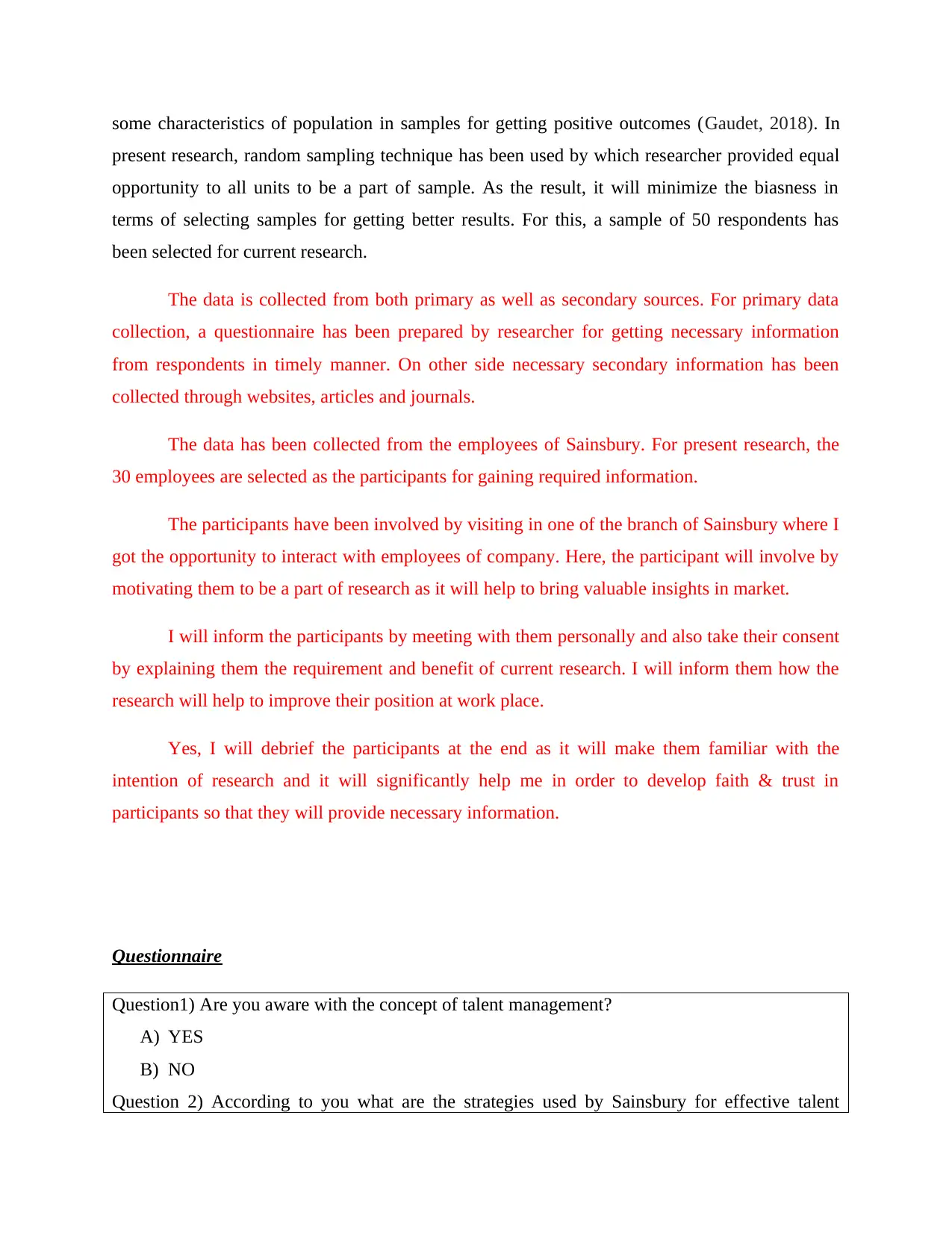
some characteristics of population in samples for getting positive outcomes (Gaudet, 2018). In
present research, random sampling technique has been used by which researcher provided equal
opportunity to all units to be a part of sample. As the result, it will minimize the biasness in
terms of selecting samples for getting better results. For this, a sample of 50 respondents has
been selected for current research.
The data is collected from both primary as well as secondary sources. For primary data
collection, a questionnaire has been prepared by researcher for getting necessary information
from respondents in timely manner. On other side necessary secondary information has been
collected through websites, articles and journals.
The data has been collected from the employees of Sainsbury. For present research, the
30 employees are selected as the participants for gaining required information.
The participants have been involved by visiting in one of the branch of Sainsbury where I
got the opportunity to interact with employees of company. Here, the participant will involve by
motivating them to be a part of research as it will help to bring valuable insights in market.
I will inform the participants by meeting with them personally and also take their consent
by explaining them the requirement and benefit of current research. I will inform them how the
research will help to improve their position at work place.
Yes, I will debrief the participants at the end as it will make them familiar with the
intention of research and it will significantly help me in order to develop faith & trust in
participants so that they will provide necessary information.
Questionnaire
Question1) Are you aware with the concept of talent management?
A) YES
B) NO
Question 2) According to you what are the strategies used by Sainsbury for effective talent
present research, random sampling technique has been used by which researcher provided equal
opportunity to all units to be a part of sample. As the result, it will minimize the biasness in
terms of selecting samples for getting better results. For this, a sample of 50 respondents has
been selected for current research.
The data is collected from both primary as well as secondary sources. For primary data
collection, a questionnaire has been prepared by researcher for getting necessary information
from respondents in timely manner. On other side necessary secondary information has been
collected through websites, articles and journals.
The data has been collected from the employees of Sainsbury. For present research, the
30 employees are selected as the participants for gaining required information.
The participants have been involved by visiting in one of the branch of Sainsbury where I
got the opportunity to interact with employees of company. Here, the participant will involve by
motivating them to be a part of research as it will help to bring valuable insights in market.
I will inform the participants by meeting with them personally and also take their consent
by explaining them the requirement and benefit of current research. I will inform them how the
research will help to improve their position at work place.
Yes, I will debrief the participants at the end as it will make them familiar with the
intention of research and it will significantly help me in order to develop faith & trust in
participants so that they will provide necessary information.
Questionnaire
Question1) Are you aware with the concept of talent management?
A) YES
B) NO
Question 2) According to you what are the strategies used by Sainsbury for effective talent
Paraphrase This Document
Need a fresh take? Get an instant paraphrase of this document with our AI Paraphraser
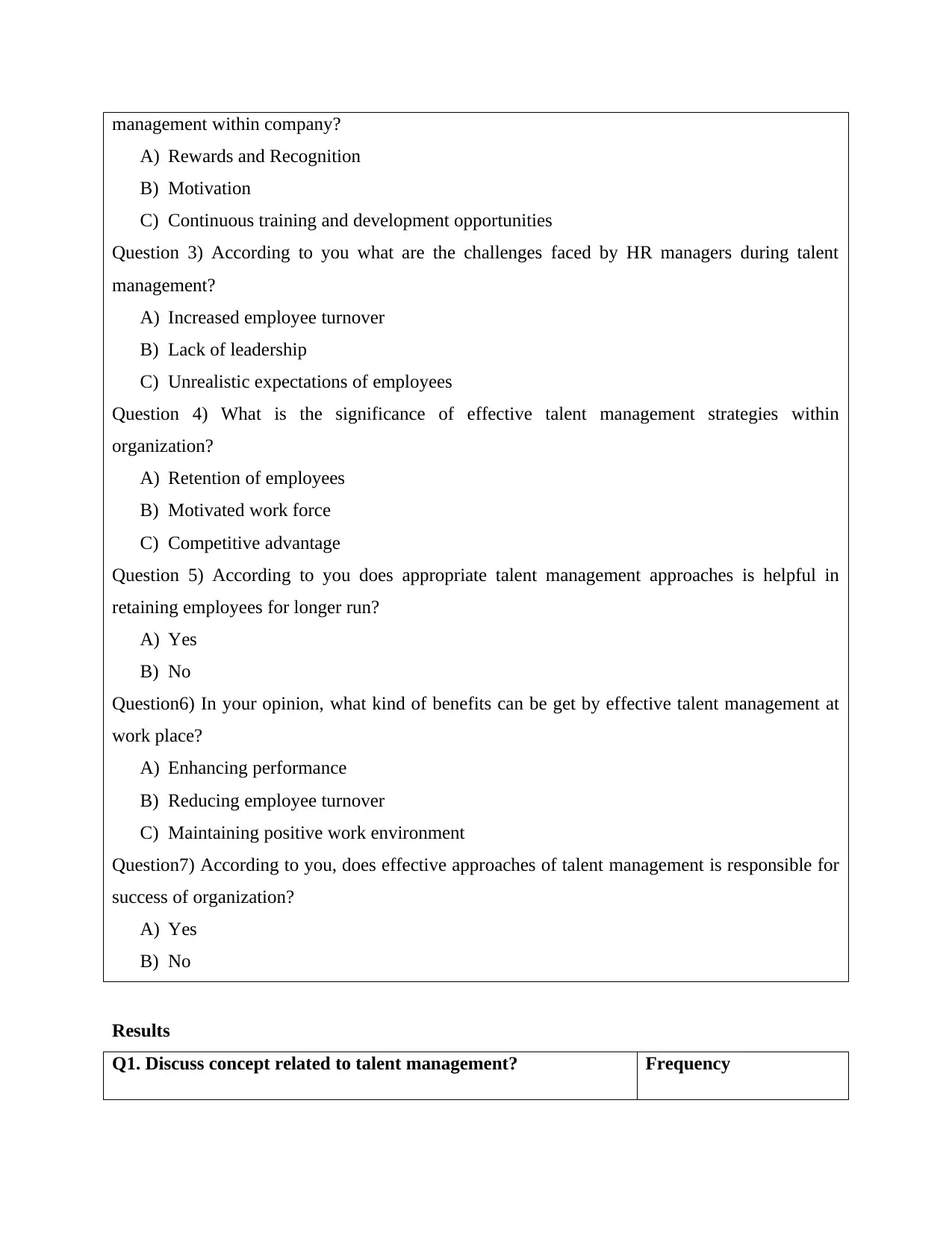
management within company?
A) Rewards and Recognition
B) Motivation
C) Continuous training and development opportunities
Question 3) According to you what are the challenges faced by HR managers during talent
management?
A) Increased employee turnover
B) Lack of leadership
C) Unrealistic expectations of employees
Question 4) What is the significance of effective talent management strategies within
organization?
A) Retention of employees
B) Motivated work force
C) Competitive advantage
Question 5) According to you does appropriate talent management approaches is helpful in
retaining employees for longer run?
A) Yes
B) No
Question6) In your opinion, what kind of benefits can be get by effective talent management at
work place?
A) Enhancing performance
B) Reducing employee turnover
C) Maintaining positive work environment
Question7) According to you, does effective approaches of talent management is responsible for
success of organization?
A) Yes
B) No
Results
Q1. Discuss concept related to talent management? Frequency
A) Rewards and Recognition
B) Motivation
C) Continuous training and development opportunities
Question 3) According to you what are the challenges faced by HR managers during talent
management?
A) Increased employee turnover
B) Lack of leadership
C) Unrealistic expectations of employees
Question 4) What is the significance of effective talent management strategies within
organization?
A) Retention of employees
B) Motivated work force
C) Competitive advantage
Question 5) According to you does appropriate talent management approaches is helpful in
retaining employees for longer run?
A) Yes
B) No
Question6) In your opinion, what kind of benefits can be get by effective talent management at
work place?
A) Enhancing performance
B) Reducing employee turnover
C) Maintaining positive work environment
Question7) According to you, does effective approaches of talent management is responsible for
success of organization?
A) Yes
B) No
Results
Q1. Discuss concept related to talent management? Frequency
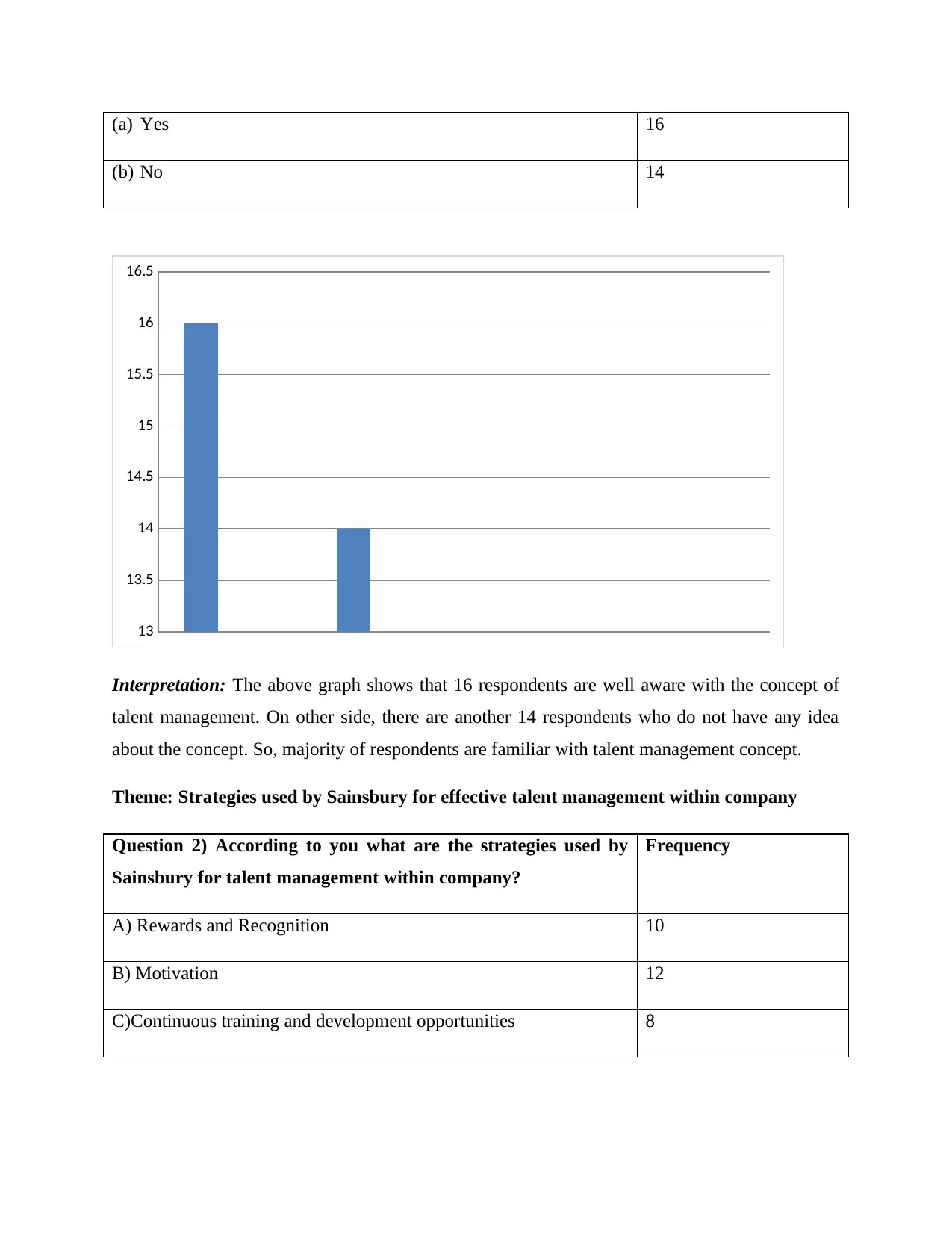
(a) Yes 16
(b) No 14
13
13.5
14
14.5
15
15.5
16
16.5
Interpretation: The above graph shows that 16 respondents are well aware with the concept of
talent management. On other side, there are another 14 respondents who do not have any idea
about the concept. So, majority of respondents are familiar with talent management concept.
Theme: Strategies used by Sainsbury for effective talent management within company
Question 2) According to you what are the strategies used by
Sainsbury for talent management within company?
Frequency
A) Rewards and Recognition 10
B) Motivation 12
C)Continuous training and development opportunities 8
(b) No 14
13
13.5
14
14.5
15
15.5
16
16.5
Interpretation: The above graph shows that 16 respondents are well aware with the concept of
talent management. On other side, there are another 14 respondents who do not have any idea
about the concept. So, majority of respondents are familiar with talent management concept.
Theme: Strategies used by Sainsbury for effective talent management within company
Question 2) According to you what are the strategies used by
Sainsbury for talent management within company?
Frequency
A) Rewards and Recognition 10
B) Motivation 12
C)Continuous training and development opportunities 8
⊘ This is a preview!⊘
Do you want full access?
Subscribe today to unlock all pages.

Trusted by 1+ million students worldwide
1 out of 22
Related Documents
Your All-in-One AI-Powered Toolkit for Academic Success.
+13062052269
info@desklib.com
Available 24*7 on WhatsApp / Email
![[object Object]](/_next/static/media/star-bottom.7253800d.svg)
Unlock your academic potential
Copyright © 2020–2025 A2Z Services. All Rights Reserved. Developed and managed by ZUCOL.




